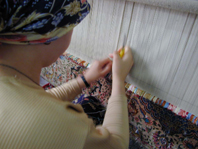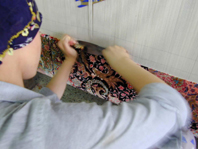|
|||||||||||||||||||||
|
Hereke carpets are created using a unique construction method.
The initial preparation of the loom is distinct from most other
techniques worldwide. Two sets of warps (threads that run lengthwise)
are employed. The first set of warps is located in front of the second
set, which is necessary to wind the threads. Other rug types simply place
the warps beside one another. The Hereke method allows the possibility of
a second weft (horizontal threads interlaced through the warp), is
thinner, and zig-zags to hold the knots in case the carpet is damaged. This is
a major difference that separates the Hereke carpet-making technique
from others.
Hereke carpets are double knotted using the Turkish knot, resulting in a more durable product. Double knots cannot be undone or removed, unlike single knots, which may come undone if pulled with force. Double knotting ensures a 45-degree angle in the pile, as opposed to single knotted carpets, which have a 90-degree angle. Carpets with a single knotted pile become shiny through use and are more easily damaged. The 45-degree angle in Hereke silk rugs causes them to have a distinct appearance when viewed from opposite ends. Natural silk fibers have a darker inner color compared to the shinier surface fibers of the thread; this difference causes the rug to change appearance depending on the viewer's angle. Hereke carpets are woven either in pure silk or cotton and wool. Hereke silk carpets are made with silk from Bursa. Hereke wool carpets are made with warps and wefts of cotton, providing greater tensile strength and allowing a denser more durable carpet. Highest quality wool is used for the knots in the pile. The knot density in Hereke wool carpets is anywhere between 360,000 to 400,000 knots per square meter. Hereke silk carpets have 1.0 to 1.2 million knots per square meter. On average, a skilled weaver can produce a Hereke carpet with 1 million knots in about one year. The knots in a Hereke carpet are tightly squeezed together using an iron comb once each knotted row is completed. This step puts all the knots in order and increases the density and strength of the carpet. Once this is done, a horizontal line is passed between the front and the rear warps. A wooden dowel set above the knotting area in the loom is then moved up, causing the rear warps to move to the front. The second weft is then zig-zagged through the two lines of warps. The wooden dowel is then taken back down and the two horizontal lines are forced down with the iron comb. The ends of the double knots, which now form the pile, are then trimmed very carefully using special scissors. This process is repeated upon completion of every single row of knots. Hereke carpets issued a Certificate of Authenticity by the Hereke Carpet Weavers Association are guaranteed 100% handmade. |
 Hereke Silk Carpet Weavers
Hereke Silk Carpet Weavers |
 Knotting Silk Threads
Knotting Silk Threads |
|
 Tightening Knots with Iron Comb
Tightening Knots with Iron Comb |
|
 Trimming Silk Pile
Trimming Silk Pile |
 |
 |
 |
|
Legal Notice | Privacy Statement Copyright © 2001-2003 Hereke Carpet Weavers Association. All rights reserved. Reproduction in whole or in part without permission is prohibited. |
||